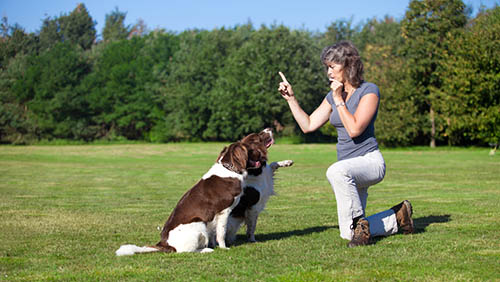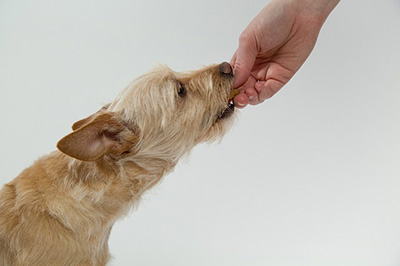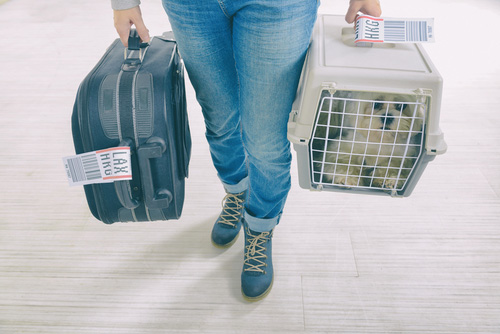Emotional support dog training is a sure-fire way to ensure that you can enjoy all the privileges of having an ESA. If you are in possession of an emotional support animal (ESA) letter, you are allowed to take your furry friend with you on most flights.
You may also be able to live in places or buildings which usually apply a no-pet-policy. By training your canine in some basic obedience skills, you can be sure to carry on enjoying those privileges as well as building an awesome bond with your best bud.
Keep in mind: Your ESA is there for you but it's a two-way street. When training, know that your emotional support dog is learning - just like you. Like children, most animals do not respond well to abrasive and aggressive training so be patient and kind. No dog is going to be supportive and comforting if you're not.
Where and How to Get an Emotional Support Dog: Any Dog Can Be an ESA!
Dogs come with a built-in mechanism that makes humans feel better and happier! An emotional support dog doesn’t have to be "specifically" trained with any particular skills. A dog that serves you as an emotional support animal provides you with love, comfort, security, and companionship.
Assistance dogs help to ease the devastating symptoms of mental and emotional disabilities. So, any dog that you love can be your emotional support dog. Big or small, fluffy or short-haired, German Shepherd or Shi-Tzu… it is up to you!
All that you have to do to make it legit is get an ESA letter from a licensed mental health practitioner (LMHP).
The Two Wonderful Laws That Protect ESAs!
Can't wait to get started?
The ESA Application process at CertaPet starts with a fast, free screening test that you can take right now. It takes only 5 minutes and shows if you may qualify for an ESA right away.
How to Get an Emotional Support Animal Letter: CertaPet’s Simple Process!
An ESA letter is a prescription from a mental health professional such as a psychiatrist, psychologist, or licensed clinical social worker. This letter states that you have an emotional or mental condition and require an assistance animal to alleviate some of the symptoms.
Conditions include, but are not limited to: anxiety, depression, post-traumatic stress disorder (PTSD), social anxiety disorder, mood disorders, panic attacks, or phobias.
Certapet has made getting an ESA letter an easy and stress-free process. The first step is to take the free, 5-minute pre-screening questionnaire. If you are eligible for an ESA letter, you will be put into contact with an LMHP for a 15-minute online consultation. Once they have assessed your needs and how your pet can be of assistance, you could qualify for an ESA letter, which could be posted to you in 48 hours!
ESA Training vs Service Dog Training: What’s the Difference?
An emotional support dog is different to a service dog in that it doesn’t require any specialized training. A service dog is specifically trained to assist an individual suffering from a disability such as visual impairment (a guide dog), mobility impairment, hearing impairment, diabetes, or seizures.
Service dogs undergo a rigorous training program to develop skills that enable them to help their disabled person with specific tasks.
Training a service dog can take a long time. Most working dogs require 1 – 2 years to be fully trained as a service dog with public access skills.
You can train your emotional support pup in basic commands in just a few weeks. However, remember that your dog’s training is never complete. It is important to continue with a dog training program throughout your dog’s life. Not only is it good for your canine’s mental stimulation, but it is also great for retaining the bond between you and your pooch!
ESA Dogs Don’t Need Special Training, but if Fido Misbehaves, He’ll Lose His ESA Privileges!
Even though your support dog doesn’t need to have an Honors degree from doggie discipline school, it is wise to teach your pet some basic good manners. You will want to enjoy the privileges of being able to take your ESA with you wherever you go. Both you and your furry friend are going to have a much easier time of it if your doggo is well socialized and well-behaved in public.
Airlines will revoke the privilege to travel with your ESA if your pet has shown aggression to flight staff, yourself or other passengers on a previous occasion.
Most establishments will not hesitate to ask you to remove your ESA from the premises if it shows unclean and disruptive behavior.
But remember, aggression goes both ways! Your emotional support animal AND you are learning how to help one another. In other words, don't be mean to your dog for not understanding some training or having a bit harder time sitting still. They love you. They want to be with you. And they will respond negatively if you do!

Why Emotional Dog Training is Important for Those with Anxiety, Depression, and PTSD
One in four Americans has an emotional condition or mental illness. Having a dog trained well, that you can rely on to behave in an appropriate manner no matter where you are, can go a long way to curbing an anxiety attack in social and otherwise stressful situations.
People suffering from conditions such as PTSD, depression, and anxiety need their animals with them wherever they go. Not just at home. So, you want a well-adjusted, obedient dog. A dog that will behave appropriately both at home and in public places.
Some dogs can even be trained to respond to certain cues or stimuli. They will then respond in a manner that will lessen or even prevent the response to a stressful situation. For example, if a person suffers from claustrophobia, their emotional support dog could move between them and others to create ‘breathing room’. A PTSD sufferer with frequent nightmares could train their ESA pup to wake and comfort them during a nightmare.
Emotional Support Animal Training 101: The 7 Most Important Commands to Teach an Emotional Support Dog
It is never too soon or too late to start training your furry friend. If you are starting out with a puppy, commence training as soon as you bring your pup home. Do not wait for the little hound to ‘settle in’.
Potty Training
Obviously, you don’t want Fido relieving himself on the subway or in the middle of a busy restaurant! Potty training is definitely first and foremost on the training agenda. To potty train your pup, be consistent, patient and reward the correct behavior.
When starting to house train your dog, limit their access to other parts of the house. As potty training becomes more successful, your new dog can gradually be introduced to new rooms or areas of the house.
Dogs are creatures of habit. Create a routine of feeding at the same times each day and offering regularly spaced walks and/or potty breaks. Doing this will condition your dog to "go" in the same place at the same times each day. As soon as your dog goes potty in the correct spot, reward with a high-value treat and over the top praise!
Recall
A good recall is one of the most valuable skills that you can teach your dog. Not only does it make you look super suave in the dog park, but it can also keep your dog from potentially harmful situations!
If you make sure that coming back to you is the most exciting thing that has happened all day (treats, a game, lots of cuddles), you will be quickly on your way to securing an excellent recall.
Stay
This is another great skill for keeping your doggo safe from harm. To train your dog with a “stay” command, build on the three D’s: distance, duration, and distraction.
Start off with your dog in a sit or down position no more than a lead’s length away from you. Give the “stay” command/signal. After a short while, reward. Repeat this until you are sure that your dog understands that if they stay in position, they will get a treat.
Over the next few training sessions, increase the distance from your dog and the length of time (duration) that they must “stay”. Once a good stay is in place, you can start to introduce distractions, such as strange noises, vehicles or people passing by.

Leave It
Asking your dog to “leave it” can apply to both unpleasant or dangerous items as well as to dogs or people that seem threatening. This skill takes patience and consistency to master. Take your time with this one, keeping the three Ds in mind.
Sit
This is usually the first command that most dogs learn. Most dogs will sit of their own accord. All that you must do is to couple that behavior with the correct command.
With your dog in a standing position, hold a treat in front of their nose. Gradually move the treat backward. As your dog follows the treat, their backside will automatically go down into a sitting position. As that happens, respond with an affirmation and a treat. When your dog learns to sit reliably with the treat lure, you can transition to a hand signal and/or verbal command.
Down
This cue is trained in much the same way as the “sit”. With your dog sitting in front of you, hold a treat in front of their face. Slowly move the treat down to the floor and away from your dog. As you do this, their body should automatically follow, leading to a lying down position. Respond with an affirmation and the treat!
Settle
This is such an important cue for dogs that will be in public places and amidst humans and other animals. With your dog on a leash, sit down and step on or hold the leash in such a way that your hound has room enough only to sit, stand and turn around. Once your doggo settles by your side, affirm and give a treat. Once they are settling of their own accord, you can start adding in your own cue.
2 Tips on How to Train a Dog in Basic Obedience
1. Keep it positive! Only spend time training your pup when you are feeling positive. Reward correct behavior. Don’t punish or acknowledge incorrect behavior.
2. Keep it brief. Rather break up your training into two or three 10 to 15-minute sessions per day than one 30 – 60-minute session.
Looking for an ESA?
The ESA Application process at CertaPet starts with a fast, free screening test that you can take right now. It takes only 5 minutes and shows if you may qualify for an ESA right away.

Emotional Support Dog Training with Positive Reinforcement!
Positive reinforcement training is a fun and effective way of training your dog. This method works for any dog breed. The principles are based on rewarding positive behavior, as opposed to punishing negative behavior.
The handler will ask a dog to perform a command. As the dog does it correctly, the trainer will respond with a vocal affirmation, e.g “Yes!!” or “Good dog!” and/or reward with a treat or a quick play or cuddle.
Training a Dog is Not Only about Obedience: It’s About Strengthening Your Bond!
With the right attitude, training your canine bestie can be fun for both you and your pup. Spending the time to learn and understand your dog’s language will bring you so much closer together.
Seeing how quickly your pooch can learn new tricks, will make you feel like a training superstar! And getting things right and impressing you will give your hound oodles of confidence and satisfaction!
Happy pet owner + happy doggo = happiness²!
